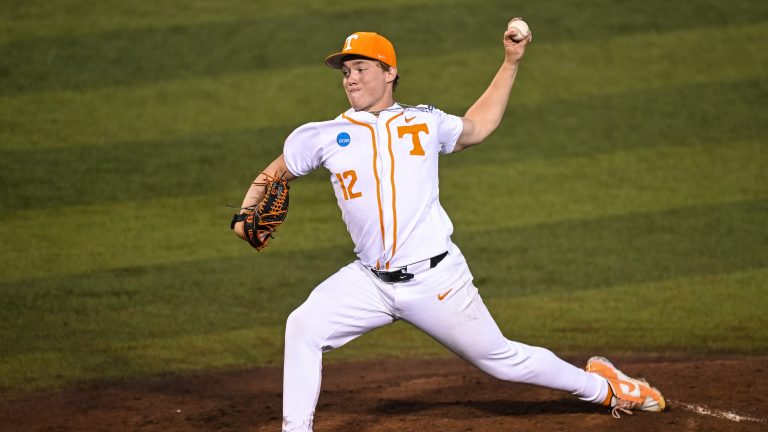Which Draft Prospects Could Make Big League Debuts in 2026?
With such a stacked class in this year's MLB Draft, let's take a look at some of the picks who could make big-league debuts in 2026.

After what feels like an unlimited amount of time hyping it up and inching closer and closer, the 2025 MLB Draft is just about here. The first day of the festivities will be on Sunday, July 13 and the first picks will be made right around 6pm ET. Day one consists of the first three rounds of the event. Rounds four through 20 will be the next day beginning at 11:30am ET.
Despite the fact that the draft is just a few days away, there’s very little (if any) clarity as far as who’s going to go first, second, third, and so on in the first round. There are a boatload of promising candidates that could be selected first-overall by the Washington Nationals, but their decision is far from made.
It certainly doesn’t help that they just sent both their manager and general manager packing, which only adds to the overall uncertainty around their organization.
In recent years, we’ve seen many more recent draftees get rushed through the minor leagues and get their first crack at big-league playing time. In 2020, Garrett Crochet was the first to make his MLB debut in the same year he was drafted since 2010. Within the past five years since then, the Los Angeles Angels have done the same thing with first baseman Nolan Schanuel and pitcher Ryan Johnson.
Zach Neto (LAA), Christian Moore (LAA), Cam Smith (HOU), and Nick Kurtz (ATH) all stick out as players who recently made their big league debuts the following year after they were drafted.
Five 2025 MLB Draft Picks That Could Debut Next Season
Since this is clearly becoming a new norm, don’t be surprised to see multiple players from this year’s class following the same path as some of these others did. While debuting in the same year as the one you were drafted in is something generally reserved for the confusing Angels organization, it feels much more likely that we’ll see players from this year’s class make big league debuts in 2026.
Let’s check out some of the top candidates that stick out above the rest in what’s going to be a stacked class.
Kade Anderson
Mock Draft Landing Spot: 1.1, Washington Nationals
Anderson, a 21-year-old left-hander out of LSU, just wrapped up a dominant showing in his second collegiate season. He made 19 starts (finishing two of them), going 12-1 with a 3.18 ERA and 180 strikeouts in 119 innings. That’s 13.6 K/9, which he paired with just 2.6 BB/9 and 6.9 H/9.
He’s got “ace” potential written all over him, and he showed that off on the big stage in the national championship. This, along with an all-around solid season on the mound, was just placed as the first-overall pick in this year’s draft in our third mock draft.
Anderson’s diverse arsenal features a 55-grade four-seam fastball, a 55-grade slider, a 60-grade curveball, and 55-grade changeup. He’s got a large toolbox at his disposal and is a typical strike-throwing pitcher.
With how pitchers are built up and developed nowadays, it wouldn’t be a shock at all for the Nationals to take him first, get a small look at him in the minors, and shoot him up the ranks so they can see their prized prospect on baseball’s biggest stage quickly.
Jamie Arnold
Mock Draft Landing Spot: 1.6, Pittsburgh Pirates
Another solid left-handed pitcher, Arnold at one point seemed like he had first-pick potential, but some of the shine has faded as the year has gone on. That’s not necessarily a knock on Arnold, but rather a tip of the cap to other draft-eligible players all over the country.
Arnold, 21, statistically stacked up against Anderson pound-for-pound this past season. The former made 15 starts, going 8-2 with a 2.98 ERA and 119 strikeouts in 84.2 innings of work. Arnold is not going to routinely hit triple-digits with his fastball, but he’s a promising pitcher that excels at both generating whiffs and inducing groundballs.
What gives Arnold an edge over many players his age is his unique release point that has drawn comparisons to defending NL Cy Young Award winner Chris Sale. Sale is quite a bit taller than Arnold is (6-foot-6 compared to 6-foot-1), but the fact of the matter is that there aren’t many dominant left-handers that do it like these guys. Arnold’s funky arm slot and great feel for his pitches (especially his Sale-like slider) could easily shoot him up the depth chart on whatever team drafts him.
Caden Bodine
Mock Draft Landing Spot: 1.27, Cleveland Guardians
Don’t worry, we’ve got more pitchers. For now, let’s shift our focus over to our first position player. Bodine is a young catcher who just helped lead his team all the way to the College World Series final, where they fell short to LSU.
He also just won the Buster Posey Award, which is handed out to the best collegiate catcher in the country. Right off the bat, that’s quite an endorsement and statement to what kind of player we’re dealing with.
Bodine, 21, hit .318 with a .915 OPS through 67 games this past season. Sure, he only hit five home runs, but the switch-hitter walked (47) a ton more times than he struck out (24). A catcher doesn’t have to hit for a ton of power if he manages to play stellar defense, hit over .300, never strike out, and get on base in other ways.
Defensively, Bodine has the chops to catch big-league innings right now. He caught 19 of 30 would-be base stealers and his head coach in Coastal Carolina agrees. “He can catch in the Major Leagues right now in my opinion,” Kevin Schnall said, as relayed by via SB Nation. “He needs some time obviously just to get acclimated to the pro game, but there’s no question in my mind he can catch in the Major Leagues right now. He’s the total package.”
A defensive profile that is already ready for the majors, mixed with a strong sense of pitch recognition and patience as a batter makes Bodine an interesting prospect. He’s got “fast riser” written all over him.
Liam Doyle
Mock Draft Landing Spot: 1.2, Los Angeles Angels
For all you pitching fans, we’re back on the left-handers now, don’t worry. Doyle is yet another high-end lefty that should fly through the minors post-draft. While Anderson and Arnold both sit in the mid-90s with their heaters, Doyle’s sits around 97mph and reached triple-digits this past year. While most of his makeup doesn’t look much like Crochet, the heat he already has in his arm certainly is reminiscent.
That fastball is what should carry Doyle up the ranks once he’s drafted. He doesn’t use his secondary offerings much, but he didn’t really have to in college. In 2025, he made 17 starts (and two relief appearances), posting a 3.20 ERA across 95.2 innings with a jaw-dropping 164 strikeouts. His 15.4 K/9 would put him near the top of MLB leaderboards, and the fact that he mixes the high-strikeout stuff with a H/9 of 5.9 is just ridiculous in the best way.
He may make his big-league debut as a high-leverage reliever, but that’s exactly what both Sale and Crochet did once they reached the majors.
Ike Irish
Mock Draft Landing Spot: 1.13, San Francisco Giants
Irish is a catcher by trade but he started getting looks at first base and in the corner outfield throughout his collegiate career with the Auburn Tigers. Irish, 21, is largely viewed as a bat-first player whose best chance at becoming a big-league regular is as a corner outfielder.
That shift in his defensive home is what warranted his inclusion in this list. He started to develop some better chops behind the plate as his college career went on, but he’s not going to be a fast-riser through the minor leagues as a backstop. Instead, he should lean on that bat to try and ascend quickly through the minors.
Irish just finished hitting 19 home runs with 58 RBI, and 65 runs scored. Through 55 games, he hit .364/.469/.710 with an outstanding 1.179 OPS. He also walked nearly 13% of the time while striking out just a hair over 14%. That kind of high-walk, low-strikeout profile is so valuable in today’s game.
The best bet for Irish to make an early MLB debut would be for him to make a shift to the outfield and let his bat, which is clearly already advanced, carry his value.


